Motorola Droid 3 Review - Third Time's a Charm
by Brian Klug on July 30, 2011 12:01 AM ESTBattery Life
Of course the next question is how battery life fares, after all, it doesn’t matter too much in a mobile device if we have great application performance but need to be tethered to a charger all day long. Back to those Cortex-A9s, the next part of the picture is what power management features are and aren’t supported. First off, OMAP4 is a synchronous architecture, which means that there’s one frequency plane for both A9s - each runs at the same clock. Both can be clock gated, however.
The important next bit is that each CPU is on its own power domain. The power states of each CPU doesn’t have to be the same, and OMAP4 supports three modes - Normal (run), dormant, and power off. You can see the different power domains as illustrated by the following diagram.
TI also provides a nice table with the supported power states and clock gating states depending on what assertions are made in the local power control module register.
What’s particularly interesting is that we can actually watch cores turn on and off both through console output on the device (by running something like dmesg) and moreover there’s even some nice software that will show us graphically. System Panel (which I’m a pretty big fan of) recently added support for visualizing load on multicore Android devices, and you can see how things fare when there’s both idle activity (CPU1 gets shut completely off), and when I’m generating tons of load by flicking the page around wildly (both CPUs are on, and clocked at 1.0 GHz).
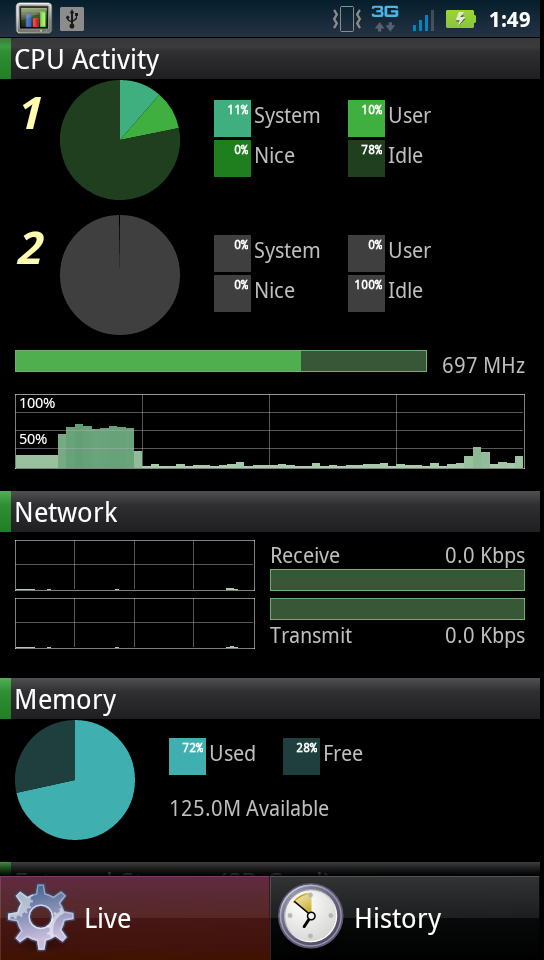
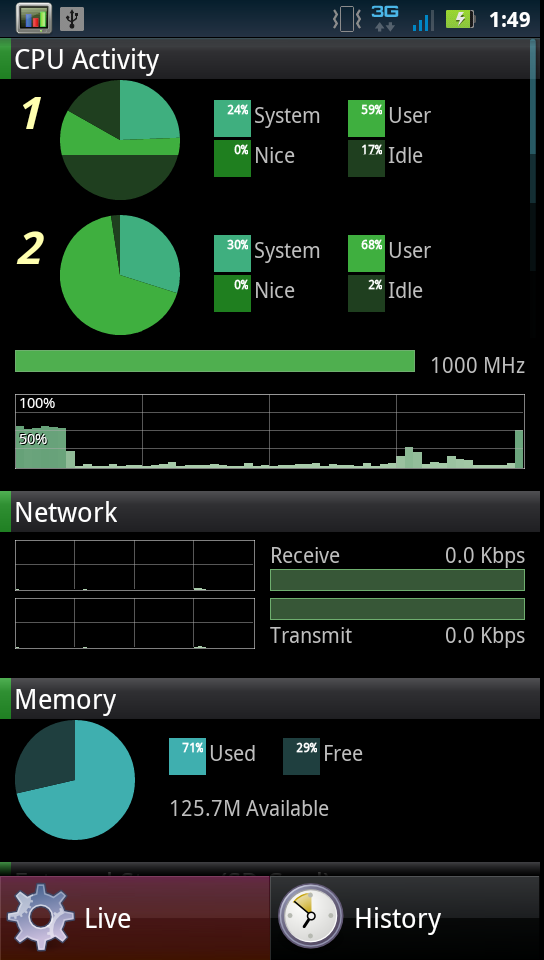
Like most modern SoCs, OMAP4 can dynamically change frequency, however it also can dynamically change voltage with a power management technique called SmartReflex. There are two different modes for SmartReflex, one which consists of an entirely hardware-controlled voltage control loop (class 3) and another which is assisted using software control (class 2). I’ve verified that the Droid 3 is using class 3:
“<6>[ 0.000000] SmartReflex CLASS3 initialized”
SmartReflex encompasses both the dynamic frequency, voltage, and power switching functions on the OMAP4430. The aim is to use silicon in the best way possible depending on either static silicon performance (given manufacturing) or dynamically based on temperature induced performance, and raise or lower voltage accordingly. To a large extent, SmartReflex it somewhat analogous to Intel’s SpeedStep and related suite, and in OMAP5 even gains a turbo mode which allows the SoC to temporarily exceed its normal maximum clock.
Now that we’ve gone over the power features of OMAP4, it’s time to present some Droid 3 specific battery life results. As usual, we’ve run our battery life testing suite on the device. The first set of tests are our page loading suite, which load through a few dozen pages every 10 seconds or so until the phone dies. The backlight brightness is at 200 nits and of course always on, to mimic continual web browsing.
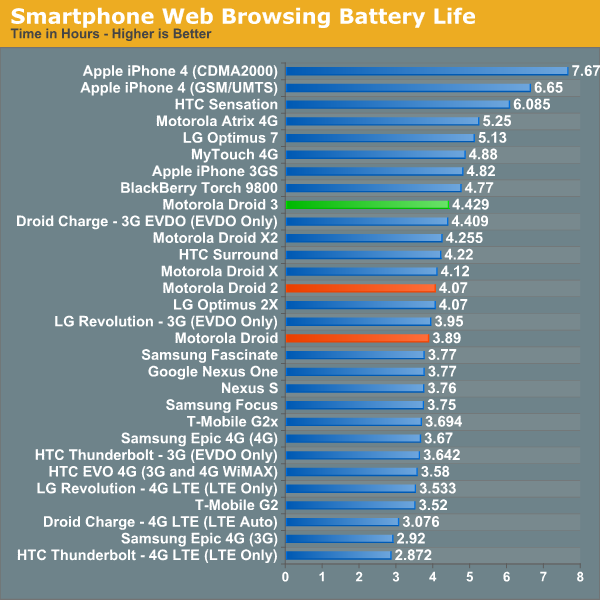
The Droid 3 both brings improvements in performance and display resolution alongside better battery life for smartphone web browsing. The other interesting performer to keep eye on is the Droid X2, which includes the same sized battery and baseband (MDM6600), but Tegra 2.
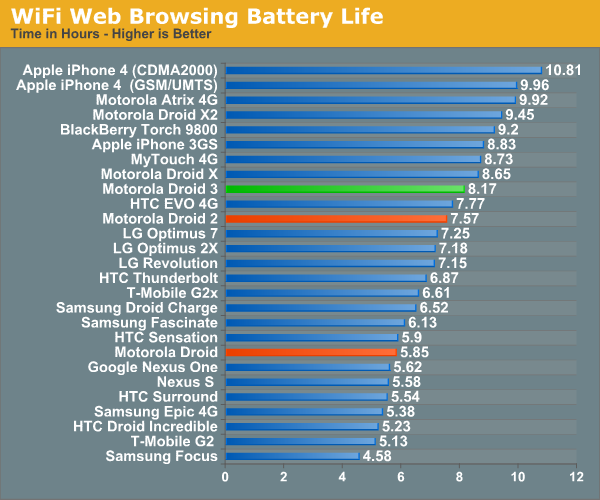
Next up is WiFi web browsing, where we run the same test but using WLAN instead of cellular connectivity. Here we can’t compare to the Droid X2 anymore as there are different WLAN stacks in each, but the Droid 3 continues to outperform its predecessors.

Motorola continues to somehow have a secret sauce for continually delivering incredibly long call time battery life, with now five spots dominated by Motorola devices. I’m still at a loss for exactly what they’re doing that gives them such a leg up, but it’s considerable.
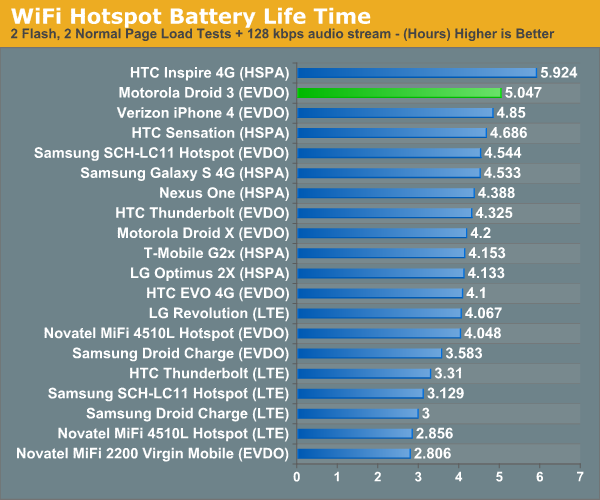
Finally is the WiFi hotspot battery test, which consists of a single WLAN client loading four tabs of our page loading test (two with flash content, two without), and a 128 Kbps MP3 streaming internet radio station. The display on the device is off the whole time. It’s a heavy test that mimics continual use and keeps everything awake on the device.
Here the Droid 3 does very well, though we don’t have any comparison data from the Droid 2 or Droid 1 due to this being a newer test. The overall results definitely illustrate the potential power savings of a dual core architecture - to put it in Anand’s words, you just can’t beat voltage scaling when dealing with power.


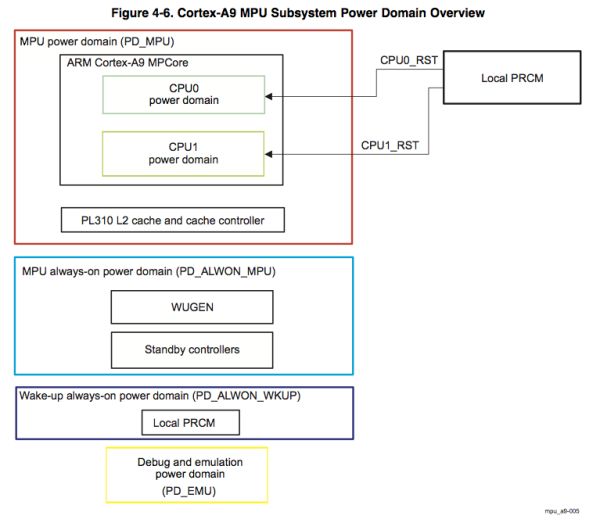
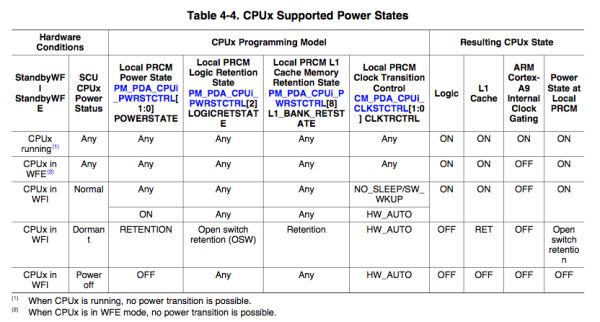








84 Comments
View All Comments
burkex90 - Tuesday, September 13, 2011 - link
Buyer beware!!!!There are only two chargers that will work properly with the Droid 3. They are as follows,
The P617 and the P510
The P617 should come in the box with the car dock and cable. Every end of the cable has a tag
with a picture of what it should be plugged into. On the large USB end of the cable it shows a picture of the P617 car charger, period end of story use this charger only!
When I ordered my car dock through Verizon $60 and change after taxes, the charger was missing. I was told to contact Motorola, they sent me a P513 charger as pictured in the article above. This charger is capable of charging the battery only, using navigation will cause the phone and battery to overheat considerably.
The P510 will charge the battery and run the phone independently of each other, leaving you with a fully charged battery after using navigation or other apps. The same goes for the P617 which should be included with the package as it is indicated on the cord.
The P510 information about its ability to run the phone independently while charging is available on the Motorola store website, click on the device then click more info. But you shouldn't have to do any of this if you received the P617 charger.
The P513 car charger fried my phone.
Please pay attention to what charger you intend on getting, the 513 ultimately cost me a $122 repair bill from Motorola.
Good luck,
Michael Burke
rinyin - Wednesday, September 21, 2011 - link
Droid3 still uses the QC MDM6600 GPS, and not the TI. It's the first to support GLONASS as well as GPS satellites, which is one explanation for performance gain.MISSY7X - Sunday, December 4, 2011 - link
JUST WANTED TO SAY THANK YOU FOR SUCH AN AWESOME OVERVIEW OF THE DRIOD 3 GLOBAL PHONE. I AM BEING SENT THIS MODEL BECAUSE THEY HAVE TO SEND ME 5 DROD GLOBAL 2'S ALREADY WITHIN ONE YEAR! NEVER DUE TO WATER DAMAGE OR DROPPING...INSTEAD ITS BEEN AN AWFUL OHONE FROM THE START. SO MANY PROBLEMS WITH EACH ONE VERIZONA DN ASURION HAD TO SEND ME. THEY ARE SENDING ME THE GLOBAL 3 MONDAY AND I WATCHED YOUR VIDEO AND READ YOUR SPECS AND THE IMPROVEMNTS. I APPRECIATED YOUR HONESTY AT THE END AS WELL ABOUT THE ONE THING YOU REALLY DIDNT LIKE AS WELL AS THE GALLERY CLUTTER :). ANUWAY, THANKS FOR EING SO THOROUGH AND HONEST!!! ~ MISSY ~MISSY7X - Sunday, December 4, 2011 - link
SO SORRY FOR THE MISSPELLING OF MY COMMENT...I SHOULD HAVE PROOFED FIRST...LOL! THX AGAIN! ~MISSY ~